
Sulawesi, also known as Celebes, is an island in Indonesia. One of the four Greater Sunda Islands, and the world's 11th-largest island, it is situated east of Borneo, west of the Maluku Islands, and south of Mindanao and the Sulu Archipelago. Within Indonesia, only Sumatra, Borneo, and Papua are larger in territory, and only Java and Sumatra are more populous.

Agamidae is a family of over 550 species of iguanian lizards indigenous to Africa, Asia, Australia, and a few in Southern Europe. Many species are commonly called dragons or dragon lizards.

Harpesaurus is a genus of lizards in the family Agamidae. The genus is endemic to Indonesia.

Hydrosaurus, commonly known as the sailfin dragons or sailfin lizards, is a genus in the family Agamidae. These relatively large lizards are named after the sail-like structure on their tails. They are native to Indonesia and the Philippines where they are generally found near water, such as rivers and mangrove. Sailfin lizards are semiaquatic and able to run short distances across water using both their feet and tail for support, similar to the basilisks. They are threatened by both habitat loss and overcollection for the wild animal trade.
Hypsilurus is a genus of arboreal lizards in the family Agamidae. The genus is endemic to Melanesia.
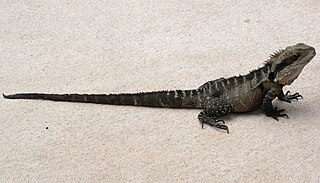
The Australian water dragon, which includes the eastern water dragon and the Gippsland water dragon subspecies, is an arboreal agamid species native to eastern Australia from Victoria northwards to Queensland. There may be a small introduced population on the south-east coast of South Australia. The Gippsland water dragon is generally the more southern of the two subspecies and the more cold adapted and heat sensitive. Visually distinguishing the Gippsland water dragon from the Eastern water dragon is relatively easy, as long as their skin is reasonably clean and not stained from the water, as identification of the two subspecies depends largely on observable differences in colours and patterns.
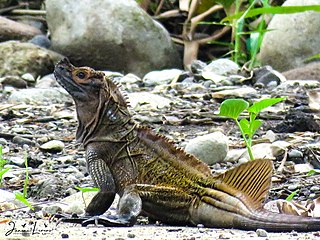
Hydrosaurus pustulatus, commonly known as the Philippine sailfin lizard or the Philippine sailfin dragon, is a large semiaquatic agamid lizard endemic to all of the major island groups of the Philippines, with the exception of the Palawan islands. Like other sailfin lizards, they are characterized by large sail-like dorsal crests on their tails. They can grow to a maximum length of around 3 to 4 ft. They are strong swimmers, and smaller juvenile lizards can run briefly on the water surface. They inhabit areas of heavy vegetation near coastlines and low-lying rivers, particularly in mangrove forests. They are also known locally as layagan or balubid in Tagalog and ibid in the Visayan languages, among other names.
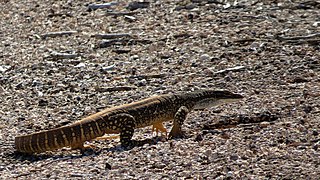
The sand goanna, also known commonly as Gould's monitor, the racehorse goanna, and the sand monitor, is a species of large Australian monitor lizard in the family Varanidae.

The Moluccan sail-finned lizard or Ambon sailfin dragon is a large agamid lizard native to moluccas or Maluku Islands in Indonesia, growing to about one metre (3.3 ft) in length. It is often confused for being the largest of the sailfin dragons; however, that title belongs to Hydrosaurus microlophus, with the second largest of the sailfin dragons being Hydrosaurus celebensis.
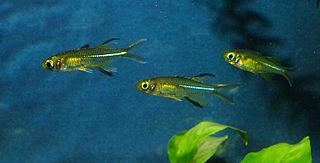
The Telmatherininae, the sail-fin silversides are a subfamily of atheriniform fish from the rainbowfish family, the Melanotaeniidae, inhabiting fresh and brackish water. All but the species Kalyptatherina helodes are restricted to the Indonesian island of Sulawesi, and most are found solely in the Malili Lake system, consisting of Matano and Towuti, and the small Lontoa (Wawantoa), Mahalona and Masapi.

The Draconinae are a subfamily of reptiles in the family Agamidae found in southern Asia and Oceania. Some taxonomists believe these genera belong to the subfamily Agaminae.

Weber's sailfin lizard or Halmahera sailfin dragon, is a species of lizard in the family Agamidae. The species is endemic to Indonesia.
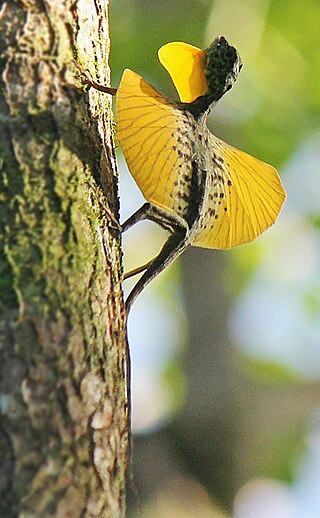
Draco spilonotus, the Sulawesi lined gliding lizard, is a lizard endemic to Sulawesi. The species is known from various localities in forested areas of Sulawesi.
Lophocalotes achlios, also known commonly as the white-throated crested dragon, is a species of lizard in the family Agamidae. The species is endemic to Sumatra, Indonesia

Hypsilurus bruijnii, also known commonly as the Bruijn forest dragon, the Bruijni forest dragon, and Bruijn's forest dragon, is a species of lizard in the family Agamidae. The species is native to Indonesia and Papua New Guinea.

The Sulawesi black sailfin lizard is a species of agamid native to Indonesia. It is the second largest species of sailfin dragon, with only the Sulawesi giant sailfin dragon being larger., exceeding 1000 mm in total length, possibly 1200 mm. Head, neck, gular region and shoulder completely black; a row of enlarged flat, sometimes conical scales on either side of the neck; nuchal and dorsal crests continuous; a group of dirty white enlarged flat scales on the anterior part of the dorsum; few (<10) additional enlarged scales approximately at midbody and before the hindlimbs. Dorsal colouration is typically yellowish, sometimes dark orange, interspersed with black spots; ventrally beige, limbs black with a few yellow spots; scales under fourth and fifth toes are broad with several keels from near the base of the toe; tail black, sail black or dark violet with black stripes.
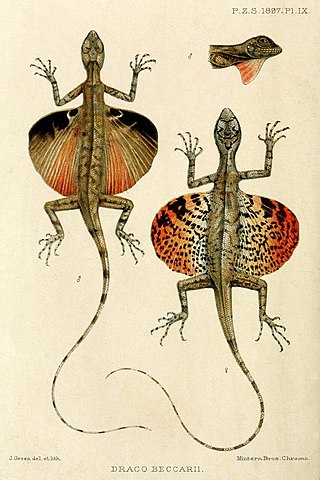
Draco beccarii is a species of lizard in the family Agamidae. The species is endemic to Indonesia.
Draco boschmai is a species of lizard in the family Agamidae. The species is endemic to Indonesia.
Draco iskandari is a species of lizard in the family Agamidae. The species is endemic to Indonesia.
There are two species of lizard named Sulawesi sailfin lizard, both native to Indonesia:















